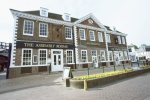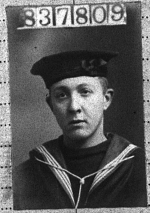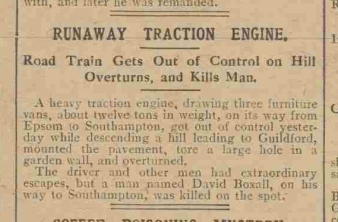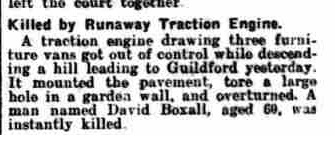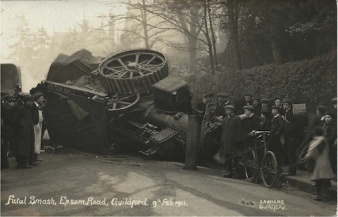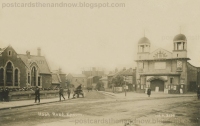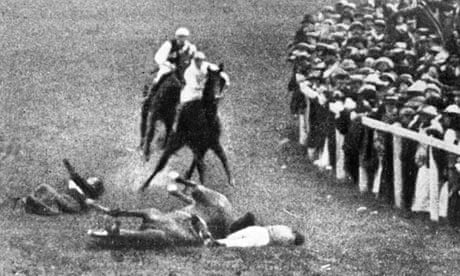|
18 Horton Hill, EpsomPreviously known as9 Oakleigh TerraceSince it was built in 1901 at least 40 people have called 18 Horton Hill home. Their reasons for living in Epsom are varied, as we shall find out. |
|
|
|
Epsom was mentioned in the Domesday book(1), and was one of the larger settlements in 1086 having 44 households. The land belonged to Chertsey Abbey which was founded in AD 666 by Frithuwold, Viceroy of Surrey.(2) |
|
In the 1600s Epsom Salt was discovered. The story of exactly how and when varies, but Epsom grew into a spa town where the purgative waters were drunk.(3) As early as 1629 Dutchmen on a diplomatic mission visited Surrey “to see some Royal Castles and Epson Wells”. Visitors included Nell Gwyn and Samuel Pepys. “We got to Epsom by eight o’clock, to the well; where much company, and there we ‘light, and I drank the water: they did not, but do go about and walk a little among the women, but I did drink four pints, and had some very good stools by it.”(4) The Assembly rooms built for the spa is now a Wetherspoons pub. (5) |
Around the same time horse racing began on Epsom Downs. In 1625 a jockey broke his neck in a fall(6) , but the sport was banned by Oliver Cromwell and the Commonwealth for 10 years 1654 to 1664. The Derby was run for the first time in 1780 and became the most famous horse race in the world. The spa, the racecourse and the close proximity to London all made the area popular with the rich. The arrival of the railways, built mainly to service the race track, in 1847, stimulated further growth of the town.
The industrial revolution brought with it social changes and by the late 1800s leaving the mentally ill in worse conditions than race horses was unacceptable. The feeling was that asylums where the mentally ill could be provided with peace and quiet, and perhaps even treatment or occupation were required. The London County Council was therefore looking for cheap parcels of farmland within easy reach of the city on which to build self-sufficient asylums. Over 1000 acres of rundown estate Horton Manor was purchased from Sir Thomas Buxton for £35,900 in 1896. Over the next 30 years five hospitals, the world’s largest cluster of hospitals for the mentally ill, were built. Five farms, worked by the patients, were established on the cluster to provide food and occupation. The entire complex included up to 12000 inmates and staff, larger than the town of Epsom itself, which had only 9000 residents in 1896.
Epsom Court, another local manor house, was also in decline. In 1893 the Chase family set up a trust to generate income for the family, mainly through the sale of land and ownership of houses.(7) One parcel of land, just off Hook Road, was sold to local builder Simeon Tugwell and his investment partner George Brodie. They built at least two terraces on this land, including Oakleigh Terrace.
The area as it was just before the house was built can be seen on the 1897 OS map. Click here to go the interactive map.
We do not know for certain, but the houses appear to have been built as three bedroom houses, with two rooms downstairs. Each house is a mirror image of the next, and from old maps it would appear that there were outbuildings at the back of each house half the width of the house. It is likely that these were outside toilets and coal stores. Houses built in this era generally did not have bathrooms, tin baths in front of the fire were the norm. Each house had a long strip of garden at the back.
Alfred Ring - 1902 - 1910
In 1902 40 year old Alfred Ring with his wife and six children moved around the corner from 9 Tenant Co-operators' Cottages (now 239-289 Hook Road) to 9 Oakleigh Terrace. In 1901 many of the houses along Hook Road were occupied by bricklayers, while the Tenant Co-operators’ Cottages were mainly occupied by joiners and carpenters, with a few electricians. Presumably they were all working on constructing the new hospitals.
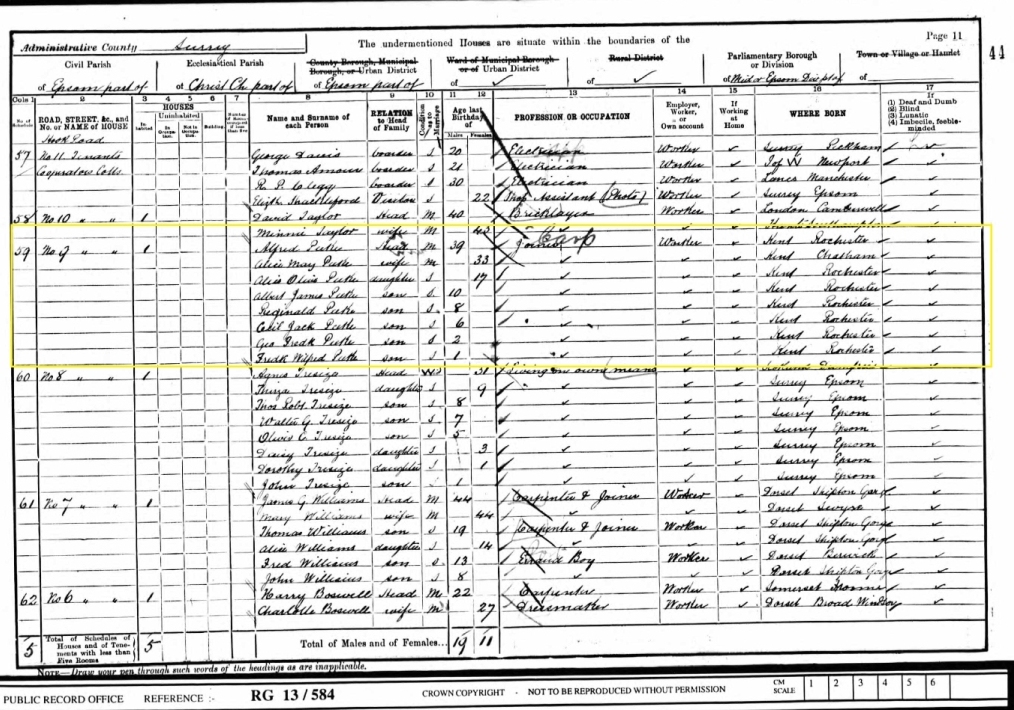
Alfred and family had not lived on Hook Road for long. Their youngest son, Frederick, was born in 1900 in Rochester where the family had lived previously. It seems the work building the hospital drew them to Epsom. They were not the only ones to live only briefly at the Tennant Co-operators’ Cottages. Their neighbours, newly married Mr and Mrs George, had spent a year at 14 Tennant Co-operators’ Cottages and moved to 8 Oakleigh Terrace. They had had 4 boarders living with them, but maybe they hoped to start a family on Oakleigh Terrace. It might be that the builder, Simeon Tugwell, took longer to complete the terraces than anticipated as several families appear to have briefly occupied the newly built Tennant Co-operators’ Cottages before moving into Oakleigh Terrace.
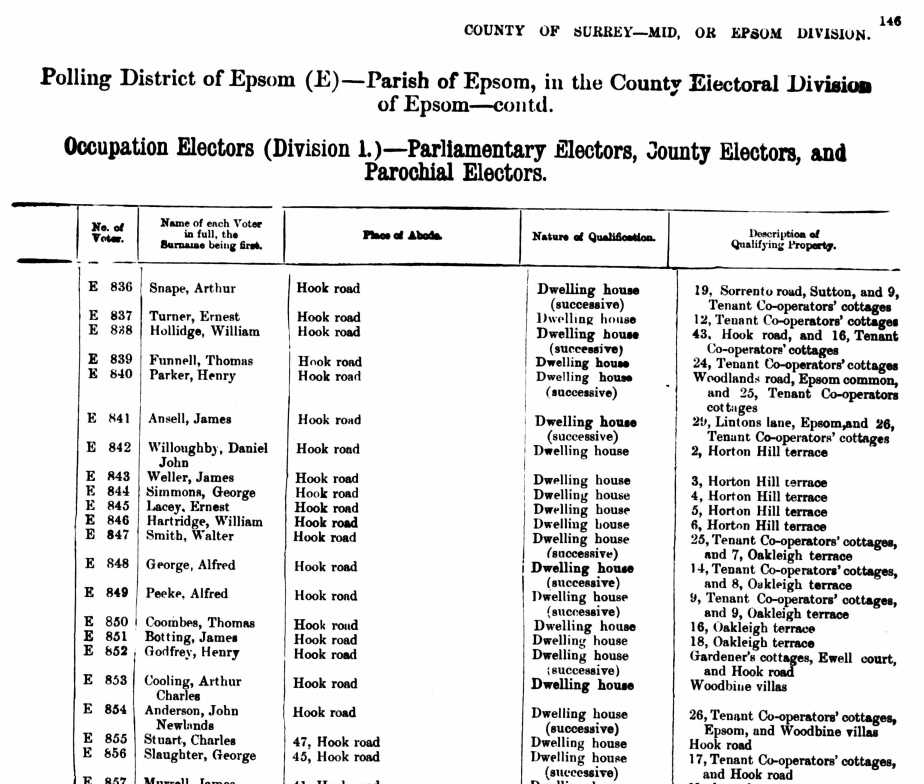 1903 electoral roll, qualification to vote is based on occupation for the 12 months prior to 15th July 1902.
1903 electoral roll, qualification to vote is based on occupation for the 12 months prior to 15th July 1902.
Alfred was born and raised in Rochester, Kent, and married Alice Mary Peeke in 1890. By the time the family moved to Epsom they had all adopted Alice’s maiden name, but reverted to Ring in 1907. I have not been able to establish why, maybe they had debts in Rochester which they did not want to follow them to Epsom?
Their new home would have been lit with gas. Electricity was available in Epsom from 5th February 1902, but at a cost of 1d to use a light for 5 hours it was prohibitive to the majority. Electric street lighting was however used from this time.
On 9th August 1902, the country celebrated the Coronation of King Edward VII. In Epsom a whole ox was roasted just west of the Tower and distributed to the assembled crowd in marquees. It seems very likely that Alfred and family would have joined in the celebrations.
 The 1902 ox-roasting
The 1902 ox-roasting
Image source: Epsom And Ewell Local And Family History Centre
As the Victorian era ended and Edward VII came to the throne Britain was entering a period of peace and prosperity. Mortality was declining as the population spread out, moving out of city centre slums, enabled by railways to live further out of town. Declining prices freed up money to allow greater spending on sewers, water supplies, food, and medical staff all improving the health of the population. As education was now free, and compulsory to the age of 12, girls especially had raised employment expectations. This meant that fewer young people wanted to go into service and live-in help began to decline.
Alice and Albert must have experienced a roller coaster of emotions over that first year in 9 Oakleigh Terrace. They moved during 1902, and in October twins May and Frank were born. In January 1903, nine year old Reginald died, from acute rheumatic purpura exhaustion, his immune system stopped functioning. Eldest daughter Alice Olive married Arthur Stevens in Christchurch, Epsom, in May 1903. Alice and Arthur eventually moved away to Ashtead where they had several children. Just three weeks after her big sister married, baby May died from whooping cough which she had been suffering from for six weeks.
In 1905 Oakleigh Terrace made the local paper when 11 year old Walter Jenner from number 12 is accused of damaging bricks and a ridge tile. We can only wonder if 15 year old Albert Ring is too old to be playing with the mischievous boys, though 6 and 7 year old George and Frederick seem very likely to be part of the dozen boys seen by Mrs Jenner.
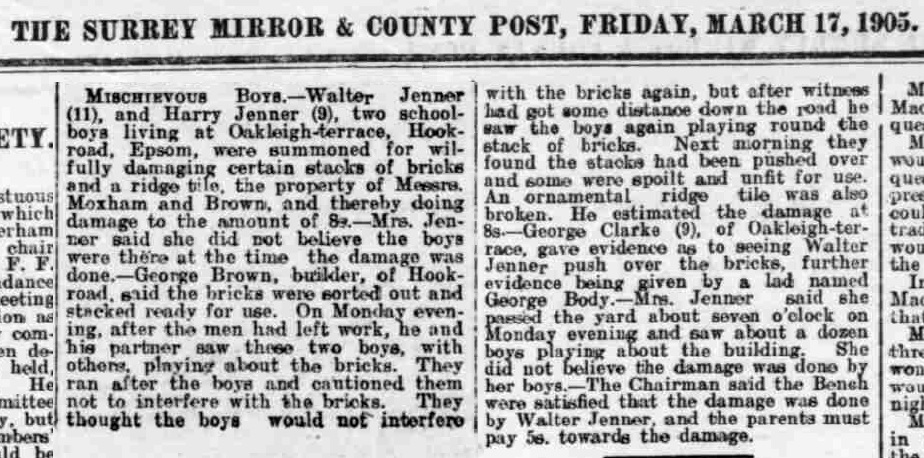
In 1907 the street was renumbered, so that 9 Oakleigh Terrace became 18 Horton Hill. For some years it was sometimes referred to as 18 Oakleigh Terrace.
We cannot know if the family were spectators for any of the events of the 1908 London Olympics, but the games went on for 6 months from April to October. It had been suggested that the marathon could take place at Epsom Downs racecourse, but the plan was dropped.
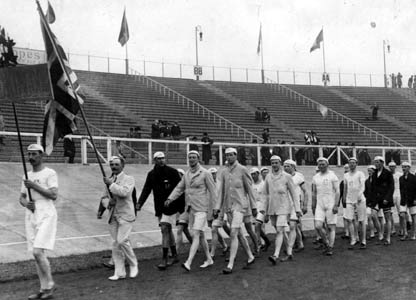 The British Olympic Team in procession at the opening ceremony of the 1908 London Olympic Games. (Hulton Archive/Getty Images)
The British Olympic Team in procession at the opening ceremony of the 1908 London Olympic Games. (Hulton Archive/Getty Images)
In 1910 Albert Ring and family moved back onto Hook Road, to 103 this time, closer to the town centre, later moving to 177 Hook Road. Albert’s namesake, their eldest son, married Janet Bridewell just before World War 1 broke out, he trained as a nurse at Long Grove Hospital. Frederick Wilfred also trained as a nurse, and both sons emigrated to Canada between the wars.
|
|
George Frederick served in the East Surrey Regiment of the army during World War 1 and afterwards joined the Auxiliary Division of the Royal Irish Constabulary, a paramilitary unit fighting the Irish Republican Army (IRA) (8). When the division was disbanded in January 1922 he, like many of his comrades, joined the British Gendarmerie section of the Palestine Police. He rose through the ranks and by 1937 he was a police inspector and was awarded the British Empire medal for meritorious service (9) before being promoted again to assistant superintendent. From there he moved to Kenya in 1948. After a spell as police superintendent he worked for the Kenya Co-Operatives Creameries. His old friend Alan Saunders, previously Inspector-General of the Palestine Police, visited him in Naivasha, Kenya, saying that George Ring had “a delightful house and garden almost alongside his offices. He hasn't been too well, but to me, he didn't look much older with the passing years and we talked ourselves hoarse". His final two years in Kenya were as a driver test examiner, before he retired to Scotland in 1962. |
Frank signed up to the East Surrey Regiment in 1920, and also fought in Europe in World War 2. He was killed in 1940 just before the evacuation of Dunkirk and is honoured on the Dunkirk Monument.
|
The baby of the family, Leslie Arthur, joined the Merchant Navy. He died aged just 31, after returning to Epsom and becoming a bricklayer. Thanks to his Merchant Navy registration card we have a photograph of him. |
Albert and Alice had 10 children but four died before reaching adulthood and two as young men. Three made lives for themselves overseas, only their oldest daughter, Alice, stayed in the area. Albert and Alice stayed in Epsom for the remainder of their lives and are buried in Epsom Cemetery, with several of their children. The grave can be viewed on the Find a Grave website.
>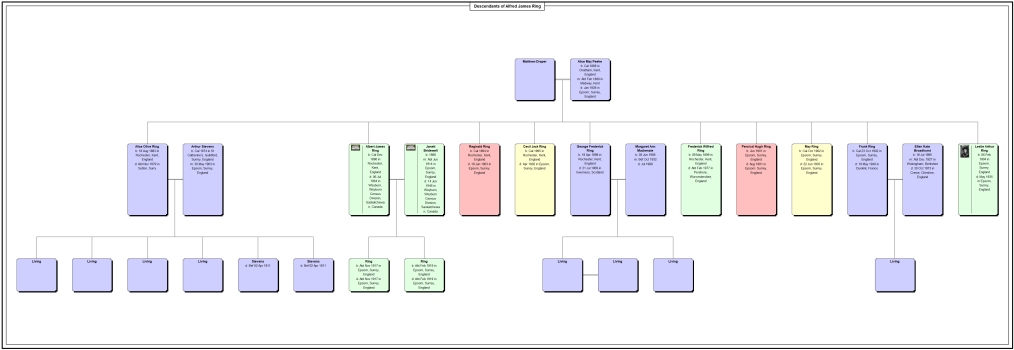
The Ring family tree. Click for a larger view.
In the time they lived on Horton Hill the population of Epsom more than doubled to over 24,000 people. The town had evolved from a faded spa town, known merely as a home to the Derby, to become a thriving market town supporting the growing London lunatic asylum complex. It was also beginning to be a commuter hub for the city as transport links improved.
William Collins - 1911 - 1912
By 1911 families had come and gone along the terrace, and now rather than building trades many families had medical professions. Along the terrace I found an assistant dispenser, asylum attendants and an “attendant at epileptic colony” as well as farm workers and a boot maker, all employed at the Horton Cluster.
At No. 4 Ebenezer Nye found his income as a carter insufficient to keep his wife and two daughters aged 6 years and 11 weeks, so one or two rooms were let to young married couple William and May Adams and their 11 month old daughter. At No. 14 labourer Arthur Killick and his wife let rooms to a widow and her two grown up sons, despite having three children themselves. Our house is one of only three on the terrace to have no one employed at the asylum. Herbert Hopgood at No. 8 was a general foreman for Epsom council, while Joseph Hepher at No. 28 was a house painter.
Number 18 was now home to WIlliam Collins (not Lady Catherine de Bourgh’s one time vicar from Pride and Prejudice), his new wife Ellen, and her sister Ethel. William had grown up in Ewell, in a row of cottages behind what is now the social club on Chessington Road, and by 1911 had joined his father, also William Collins, as a traction engine driver.
It isn’t clear whether it was father or son driving the traction engine and its trailer to Southampton when it crashed on Epsom Road shortly before midnight on February 9 1911. The Surrey Advertiser of February 13, reporting the inquest into the death of David Boxall, 65, of Epsom, said that eyewitnesses saw the traction-engine careering out of control at 12mph. The driver, William Collins, told the inquest that he tried to put the engine into reverse gear when he realised how steep the road was, but the gear pin fell out and he lost control of the vehicle. A verdict of accidental death was returned.
|
Two months after the accident the family would have heard about the sinking of the Titanic. They may have read it in a newspaper, or seen it on a newsreel at the new cinema which had opened in the Autumn of 1910. “The Electric Theatre” was on the corner of East Street and Hook Road. |
>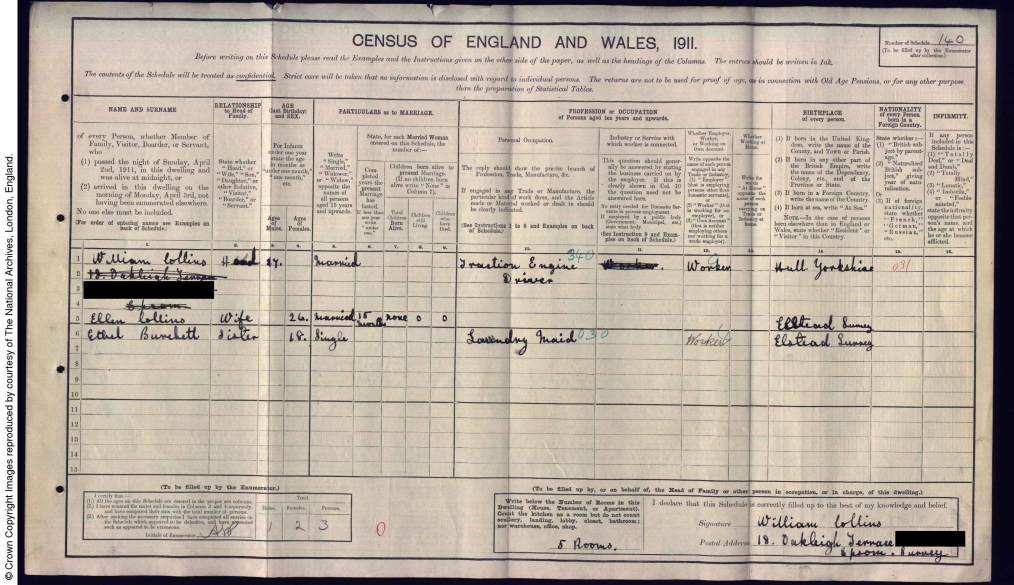
18 Oakleigh Terrace on the 1911 Census taken on 2nd April 1911.
The following year William and Ellen had a son, Frederick James, who they had baptised at St Barnabus Church. They then moved away in 1913 but I have been able to find out little about where they went. Ellen’s sister Ethel was living in the village of Seale near Farnham by December 1914 when she married William Hewett, a gardener. William and Ellen were living in Hammersmith as World War 2 broke out he was working as a labourer.
Joseph & Esther Goulding - 1912 - 1922
Once again a newly wed couple moved into No. 18 Horton Hill. Joseph and Esther Goulding married in spring 1912, in Lancaster, and moved into the house soon after. Joseph came from a family of Irish Roman Catholics, and Esther was from the Lake District. Joseph had been living in staff accommodation at Long Grove Hospital where he worked as an asylum attendant, and Esther was in staff accommodation at the Lancaster County lunatic asylum where she was a nurse.
An older couple, both in their thirties when they married, they lived in our house for 10 years, and as far as I can tell had no children. Despite her experience and qualification as a nurse Esther would not have worked at the hospital cluster as married women were not employed there at that time. Joseph would only have cared for the male patients, the hospitals were entirely segregated. The majority of male patients were single and poor, in other circumstances families were expected to provide care. Alcoholism was a common reason for admittance, after World War One many were suffering from shell shock. Joseph would have assisted to maintain a strict unvarying schedule each day.
A 1906 Commissioners Report laid down the following meals: Breakfast, 1 pint of cocoa, tea or coffee, 6oz. Bread, ½oz. margarine per patient. Tea, 1 pint of tea, 5oz. bread, with ½oz. margarine OR jam. OR 3oz. cake (cost of which should not exceed 1¾d per lb.) and up to 3oz. extra bread if requested. OR 4oz. of stewed fruit or rhubarb (grown on the hospital farm) sweetened with 1oz sugar. Dinner 4 times a week 5oz. cooked meat OR 12oz fish (including the bones) OR 1 pint Irish Stew. All with 17oz assorted vegetables. The remaining 3 days a week pies (meat or potato), fish OR Irish Stew, broth OR pea soup. When followed by a pudding, the pies allowance was reduced by half and while pea soup could be followed by a pudding, Irish Stew need not be followed by a pudding.
After breakfast the patients deemed capable would have been taken to their “jobs”, in the kitchens, farms, workshops and boiler rooms, or maintenance of the wards. They would have spent some time outside, and there would have been team sports to aid recovery. There was little knowledge of psychiatric conditions or treatments, patients were generally kept calm and occupied. Restraint was used where necessary.
As far as we can tell, the couple both stayed in Epsom throughout the first world war, with Joseph working at the asylum.
|
In May 1919 this advert appeared in “The Stage” giving the address of our house for respondents to apply. As far as I can tell, this is the only time the advert was placed. Joe Halpin was a musician and actor in the Drogheda area of Ireland following the war. Like Joseph Goulding he was from an Irish Catholic family, and may have briefly tried his luck in England. |
Joseph and Esther moved back to Cumbria in 1922 and Joseph worked as a bus conductor.
The Turners - 1923 - ?
In 1923 Albert Edward Turner and his wife Brenda Lucy moved into our house with their newborn daughter Margaret. They had married in Eastbourne in 1921, but Albert had been training as a nurse at Long Grove hospital since 1918. Brenda, had grown up in Eastbourne with her two sisters and two brothers, the daughter of a policeman. She had taken an apprenticeship as a dressmaker.
Margaret died aged just 5 in June 1928, and is buried in Epsom cemetery. Poor Brenda was expecting as she buried her first daughter, and their second child Olive was born just six weeks later. Another daughter followed 4 years after her.
The family seem to have led a quiet life, appearing in very few records. Little is known about the family, although Albert continued to work at Long Grove Hospital as a qualified nurse. By about 1935 times may have been harder, as it appears the family took in lodgers, Frederick Patrick Grace in 1935, and Josiah William Cummings for the following two years.
Brenda and Albert almost certainly shopped at Dorsets in Waterloo Road, an ironmongers which had its own foundry on the premises. They sold gas and electric lighting, plumbing items, brushes and wood.
The council supplied electricity, and a new Electricity Office and Showroom had been opened to the public in Church Street. Here, for 2/6d a quarter, they would have been able to rent one of the latest electrical ovens, kettle included. But there was an alternative at the showroom of the Wandsworth & District Gas Company, for those not yet using electricity.
There were at this time fifteen different cafes and refreshment rooms in Epsom, no doubt frequently by housewives such as Brenda Turner during her shopping trips. These included the Ivydene Luncheon Rooms and Tea Gardens in South Street and Riddingtons in the High Street. Pubs trading in the town centre included the Railway Hotel in Upper High Street, the George, the Spread Eagle, the Kings Head and the White Hart.
Albert and Brenda would have been able to buy all their baby needs locally. Edward Thomas the cycle dealer of East Street also supplied prams, nursery furniture and wheeled toys. Sidney Best, the chemist, advertised everything for baby, as well as surgical and sickroom requisites, and provided a 24 hour emergency service.
The area changed considerably in the 40 years since the house was built. Click here to go an interactive 1936 map of the area.
>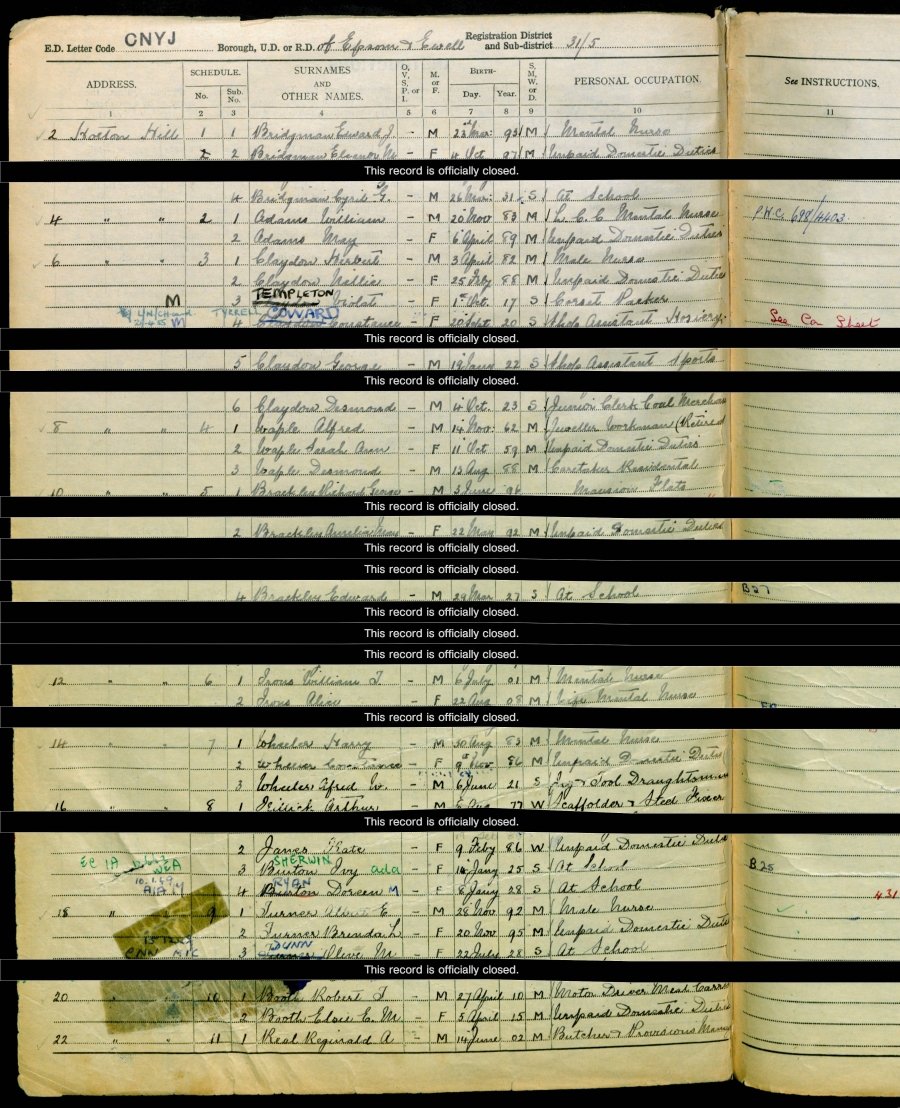
Our house on the 1939 Register taken on 29th September 1939. The younger child is blacked out as she was born less than 100 years ago.
At the eve of World War 2 Olive was attending school but the younger daughter's record is closed, until either her one hundredth birthday or her death. Brenda was a housewife and Albert was still nursing, which as far as I can tell he continued to do throughout the war. Olive's surname is changed on the register showing her marriage, the register was kept updated throughout the war and for years afterwards, forming the basis of the NHS "database".
Our road escaped bombing though several fell along Almond Road, between Longmead Road and Andover Close so the Turner’s were probably concerned. A high explosive device fell at Long Grove Hospital on 12th November 1940.
In 1949 Olive married Cyril Dunn, and had a son the following year. Olive appears to have continued to live with her parents through the 1950s, though Cyril doesn’t always appear on the electoral roll. I believe Cyril Dunn was a reporter for the Observer, writing from India and South Africa amongst other places. I cannot confirm if this was the same person, but given that Olive’s husband seems to be often absent it seems likely. Their son attended Pound Lane School.
The younger Turner daughter married Lawrence John Charles Norcross in 1954, he was an active member of the communist party throughout the 1950s. He became a secondary school teacher in South London, a passionate believer in equal educational opportunities for all. He spoke out about the benefits of corporal punishment and streaming. His politics moved right, as the Labour party tried to outlaw streaming in schools. He was headmaster of Highbury Grove boys' comprehensive in north London, which was at the heart of the battle to preserve state schools from the grip of Left-wing activists, and received an OBE for this position. He was instrumental in the grant-maintained school movement of the late 1980s and 1990s, and also made major contributions to the conservative party’s first National Curriculum in 1988. He died in January 2010 |
The youngest Turner daughter and Lawrence Norcross parted ways and she remarried in 1965, apparently staying in Surrey.
It is not currently possible to work out when the family left our house, sometime after 1962, as records after this are not available online and it is not currently possible to research in archive centres. By 2003 Olive was living around the corner, and her son moved into his mother’s house around the time of her death in 2007.
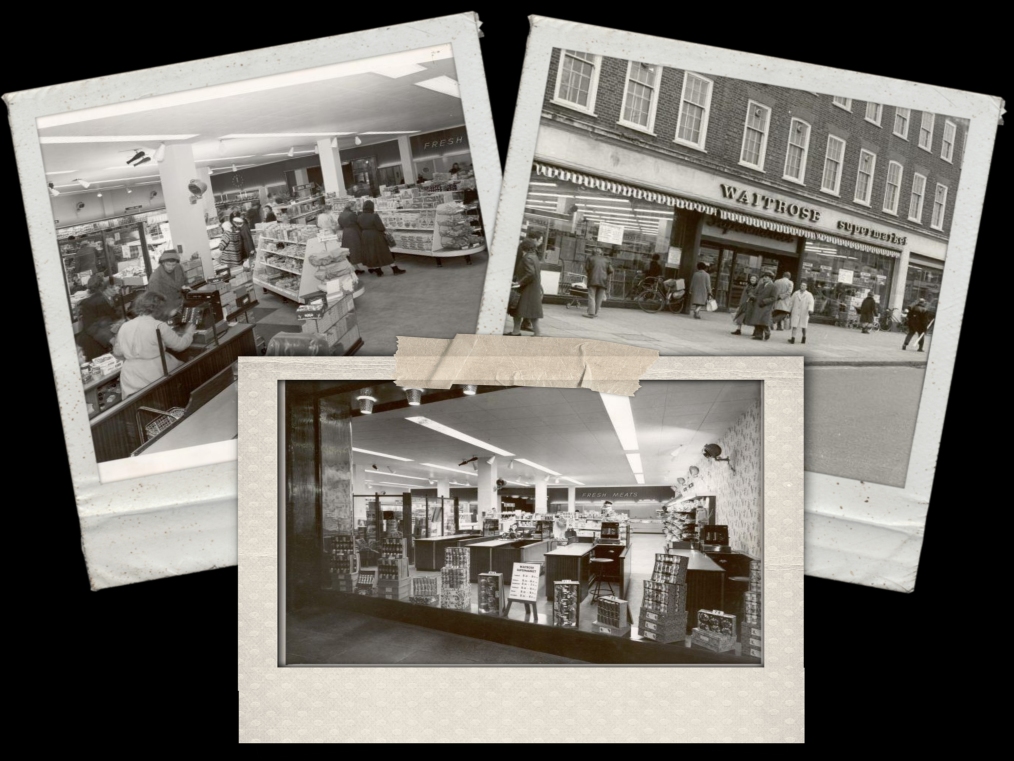
© John Lewis Partnership archives 1955-1970 Epsom
Mrs B and her son ? - 1996
The current next door but one neighbour told me that when they bought their home in 1984 Mrs B and her son were living in our house, and that they moved away in 1996. Data protection and GDPR rightly make finding out about people this recent much more difficult.
Young professionals and students - 1996 - 2010
From 1996 the house had a series of short term tenants. I know of at least one student living at our house during 2004-2005 while completing a BA Hons in Graphic Design at the University of Creative Arts, she is now a senior creative designer based in London. I suspect, but have not been able to confirm that some of the other residents attended the same university.
Google provided another tantalising glimpse of who lived in our house during these years. Adam and Anna who lived there for 4 years and transformed the house from a student dump, married in 2014. Awww.

Names and address removed for privacy reasons. The website is long gone.
The final tenants seem to have undone the work of Adam and Anna, leaving the house full of rubbish and broken furniture which my clients removed and cleaned before beginning the construction of a new kitchen and bathroom extension.
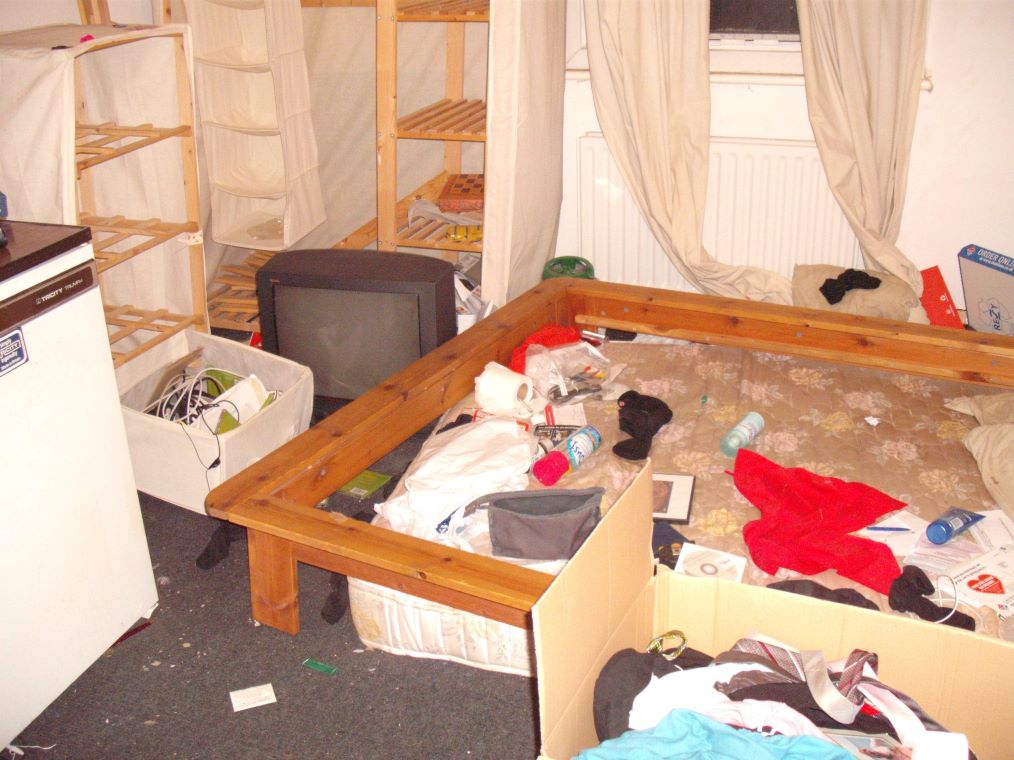
One of the bedrooms at the time of my clients final viewing prior to purchase of the house.
Back to a family home 2010 - 2021
In November 2010 my clients purchased our house and have turned it back into a forever home. After generally making the house clean and tidy they embarked on removing the poor condition bathroom extension at the back of the house and replaced it with a full width kitchen and bathroom. This meant for a while they had a temporary kitchen/bathroom in the dining room.
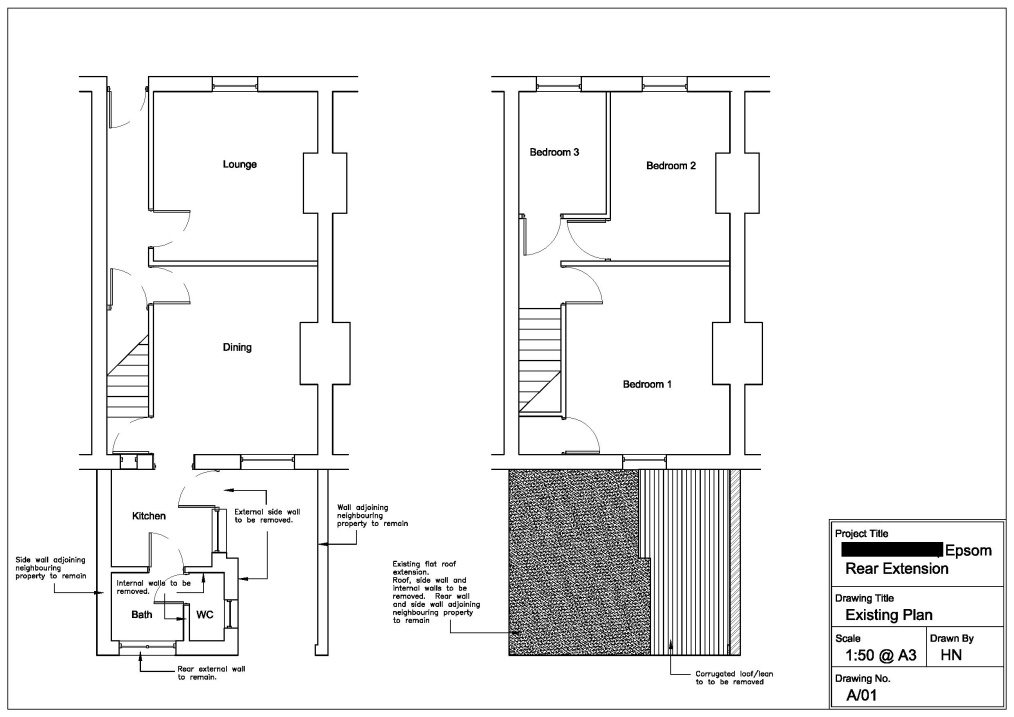
Floor plan in 2010
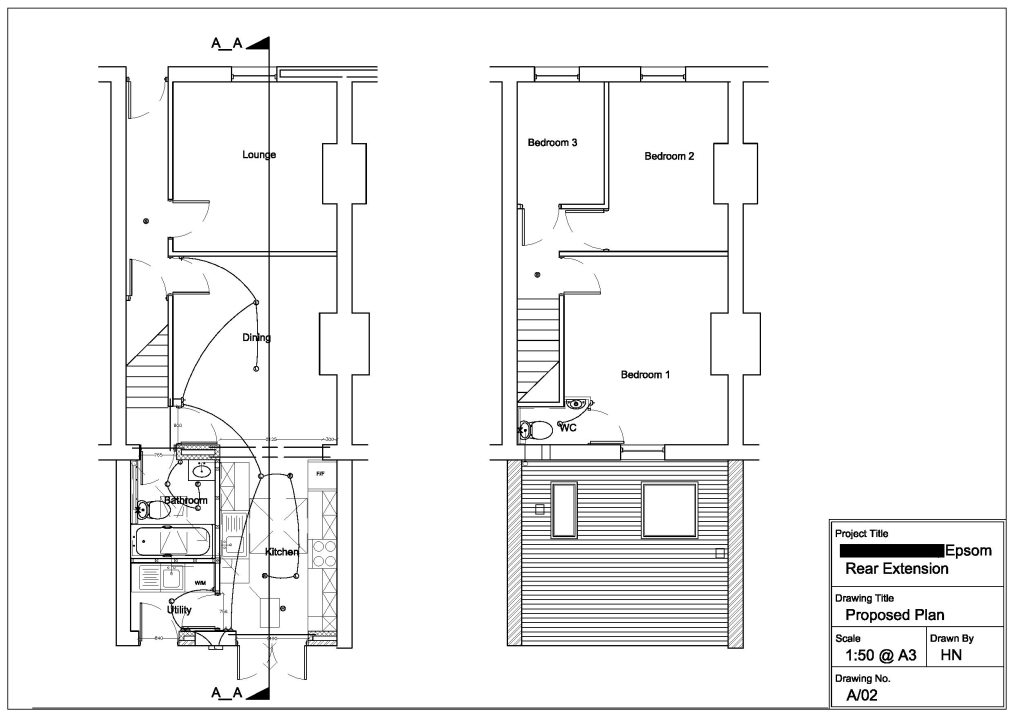
Floor plan after work was completed on the house in 2012.
My client's son was born in 2013 and the house was finally a family home again.
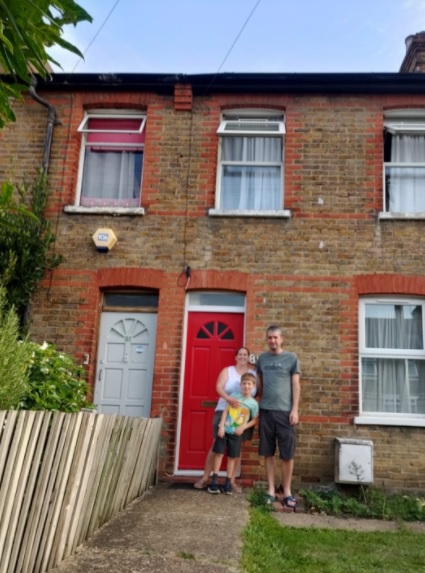
Outside the front door in summer 2020.
The Covid-19 pandemic in 2020 led to job changes and my clients moved on in 2021. The house was sold and once again 18 Horton Hill begins a new chapter for new people.
Take a tour of 18 Horton Hill in spring 2021 here. As you tour the house imagine all the lives that have been lived here.
This page was last updated on 24 December 2021.


